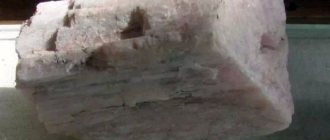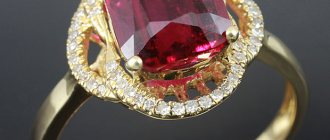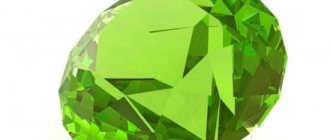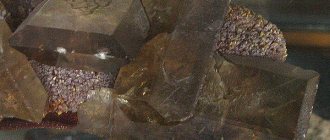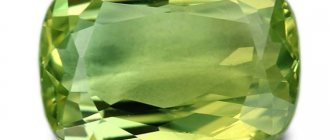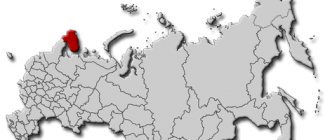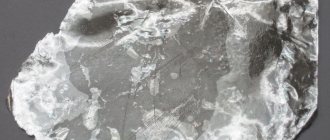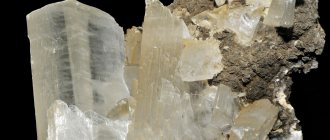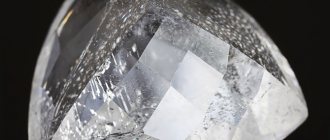Free picture (Cuprite) from https://torange.biz/cuprite-39449
Cuprite is a crystalline copper oxide, it is not rare and is very beautiful. Unfortunately, it is not popular for a wide range of consumers. Cuprite stone has magical and healing properties, astral significance and various influences on the signs of the Zodiac.
Story
Perhaps the most exciting thing in the history of the mineral is the vicissitudes with the name:
- In 1546, the alchemist Gregory Agricola dubbed it red copper.
- Two hundred years later the stone was called octahedral copper ore, red copper glass, ruby copper.
- In the 19th century, the Austrian scientist Haindinger came up with the current name. It has been entrenched in international catalogs since 1959.
On the territory of the Russian Empire, the first specimens of cuprite were found in the Urals in the 18th century.
What is
The name of the mineral reveals its origin: the Latin cuprum means copper.
Cuprite and copper
A typical cuprite has many faces:
- It is a transparent or translucent agglomerate of red-brown shades, sometimes with greenish veins. The best samples are endowed with raspberry, ruby, and wine flowers.
- It shines highly after polishing, reminiscent of metal or diamond.
- Pure mineral is distinguished by a rich, uniform color.
But more often the crystals are defective, with growths on the surface.
A unique characteristic of cuprite is the dependence of the quality of the material on its dimensions. The most valuable are small crystals.
Properties
The name of the mineral, translated from the Latin “cuprum”, sounds like copper. Most specimens in nature are colored red-brown. At the same time, the eye is pleased with a completely unexpected tone - from raspberry to languid wine. Sometimes there are options with green veins.
The mineral shimmers with a barely noticeable metallic diamond shine.
The stone has a diamond or cubic shape. On deposits it forms granular growths. In most cases, mineral crystals have defects; various growths and ingrowths of its surface are visible on them. A characteristic feature of the stone is the difference in the quality of the crystals according to their size. It is the small specimens that are most valued. To examine the stone in detail, you need to equip yourself with a magnifying glass. Extraordinary beauty is visible when malachite chalcotrichite grows with native copper.
Pure mineral has a rich, uniform color. After polishing, the surface shines well. Prolonged heating by the sun's rays causes a decrease in shine and the color fades.
Accompanying minerals of cuprite are azurite, malachite and others, which are cut like a cabochon.
Considering the low hardness of the gem, which corresponds to 4 on the Mohs scale, during processing or intensive wear it can crack, so jewelry with it will not last long. More often it can be found in mineralogical collections.
The mineral has a molecular weight of 143.09, cubic system and imperfect cleavage.
Chemical composition
The basis of the mineral is Fe, Si, Pb and various impurities, chemical formula Cu2O. In addition, the amount of a particular element varies depending on the deposit. For example, in specimens taken from deposits in the Altai region, traces of Sn and Bi can be observed. The minerals of the Hungarian deposit contain 88.62% Cu.
Origin
High-quality samples are formed under exogenous conditions. Their formation occurs in the area of oxidation of copper deposits. They may indicate the presence of copper-enriched sulfides at great depths. In rare cases, the formation of large accumulations of stone indicates the presence of carbonate rocks nearby.
Physico-chemical characteristics
According to the chemical classification, the mineral cuprite is copper oxide.
| Formula | Cu2O |
| Color | Brown-red, purple-red, red, black (with green oxides) |
| Stroke color | Shiny metallic brownish red |
| Shine | Diamond, semi-metallic, matte |
| Transparency | Transparent, translucent |
| Hardness | 3,5 — 4 |
| Cleavage | Imperfect |
| Kink | Conchoidal |
| Density | 6.1 g/cm³ |
| singonia | Cubic (hexoctahedral) |
The base composition is diluted with impurities.
Characteristics of the mineral
Since the mineral cuprite is derived from copper (I) oxide, its color range varies within the red spectrum, acquiring a wide variety of shades: dark red, crimson red, burgundy, purple, red-brown, brown, carmine red, crimson , scarlet. It is also characterized by many other shades of red. The color of cuprite is unstable and can change when exposed to solar radiation. There are forms interspersed with green. Crystals of this mineral usually take on a cubic or diamond shape.
The size of one such crystal usually does not exceed 3-5 cm, but unique rarities weighing several kilograms are also found. Copper in the mineral makes up about 90% of its mass, the remaining 10% is occupied by various types of impurities. Defects such as accretion, ingrowth and growths are almost always observed. Polished stone is characterized by a diamond or semi-metallic luster. It does not conduct electricity and is fragile in structure. The breed has similarities with almandines and pyropes.
The melting point of the oxide is 1234°C. In terms of chemical properties, the rock dissolves in hydrochloric acid to form a copious white precipitate. Also soluble in ammonia water, caustic soda, nitrate, orthophosphate and sulfate acids. For structural etching, diluted nitrate acid is used. Mercury chloride and caustic potassium have no effect. Cuprite can also be obtained artificially: by calcining metallic copper when reacting with oxygen, alloying the same metallic copper with its sulfate or copper oxide with copper chloride, through reduction in an alkaline medium, pyrolysis of a saturated solution of cuprous acetate, etc.
The stone is mined in many regions
Place of Birth
- There are several mines in the Sverdlovsk region, of which Mednorudyansky, Gumeshevsky, Turinsky, and Pyshminsky are notable.
- The mineral cuprite is also found in such mines of Rudny Altai as Zmeinogorsky, Talovsky, Loktevsky, Nikolaevsky and Bogoyavlensky.
- On the territory of Kazakhstan, the rock is found in the mines of Dzhezkazgan, Chokpak, Uspensky, Akchagyl, Berkar, Bes-Tube, etc.
- In addition, stone deposits have been discovered in Uzbekistan, Azerbaijan, Armenia, Kyrgyzstan, Primorsky Krai, France, England, Africa, and the USA.
Place of Birth
Deposits are formed in a microclimate with conditions for the oxidation of copper deposits. This made the mineral a marker by which copper is found.
Reserves of raw materials have been discovered in Australia, the USA, Hungary, and Russia (Altai, Ural).
Jewelry grade material is mined in southern Africa, in Namibia.
The description of African stones is similar to the expensive varieties of garnet - pyrope and almandine. Only special equipment can distinguish them.
Application
Since cuprite is characterized by fragility and low hardness, which complicates the cutting process, it is not widely used in jewelry. With successful cabochon polishing, it is possible to obtain the purest crystals weighing 300 carats. Typically, stones that can be processed are mined in Namibia. Relatively transparent crystals are used for jewelry; processed red stones with azurite and malachite inclusions are especially popular.
Cuprite is considered a beautiful mineral, and its subtle metallic luster gives the stone elegance and charm, which is why it is used as an insert and ring, earrings and neck decoration. Due to the high risk of wear and tear, this type of jewelry should not be worn daily. It is also used for the manufacture of printed circuit boards, for processing ceramics, etc.
In the city of Kirov there is an ecological plant named after this stone. The enterprise includes several workshops, and one such workshop is engaged in the processing and disposal of industrial waste.
How to wear and care
Cuprite is vulnerable to external factors.
You need to care for it carefully:
- Select separate boxes for storing jewelry; buy collectible pieces in a box.
- Protect from heat sources, direct sunlight, and do not wear on the beach - the stone will fade and fade.
- Acids and alkalis destroy the mineral.
The stone looks best in the evening or under artificial light.
Contaminants are removed by holding for a short time in a weak soap solution.
Therapeutic effect
The influence of the mineral is manifested physically and emotionally:
- Blood conditions are normalized: coagulation, hemoglobin level.
- It is important as a lady's healer, relieving the condition during menstruation.
The stone helps to overcome addictions of any kind: alcoholism, drug addiction, smoking. Useful for avid gamblers and shopaholics.
It is also suitable for people who are often nervous, unable to control emotions, get tired easily, or suffer from cramps.
Medicinal properties
According to lithotherapists, cuprite has a positive effect on the circulatory system, which is especially important for women, since wearing jewelry with the mineral normalizes the menstrual cycle and relieves antispasmodic pain . In some regions, there is a belief that cuprite helps a person get rid of addictions. It reduces the craving for nicotine, alcohol, drugs, and heavy fatty foods.
Thanks to the gem, hematomas inside the body resolve much faster, and the tone of muscle tissue also improves. The last property of the stone is of particular benefit to athletes, increasing the quality of training several times. In addition, the body's endurance increases significantly. It also helps with kidney diseases.
Magic properties
The magical properties of cuprite are manifested ambiguously:
- The stone helps to establish a microclimate in a team or family.
- Attracts success to the owner, makes him lucky.
- Activates dormant talents and abilities.
However, there are conditions:
- His magic “serves” only honest, decent people.
- Having achieved success, it is advisable to become a philanthropist.
- Constant use of the mineral inhibits brain activity.
Only unprocessed cuprite can be a talisman or amulet.
Practical use
Medicinal properties
First of all, cuprite, thanks to its components, has a positive effect on the hematopoietic system. Traditional medicine uses it to normalize the menstrual cycle and reduce pain during it. Some nationalities are confident in the stone’s ability to help people with various addictions. Regular wearing allows you to get rid of not only drug or alcohol addiction, but also cope with addictions to fatty foods or the computer. It has also been noted that athletes who wear it as a talisman improve their results, since cuprite gives endurance and increases muscle tone.
Magical influence
Bioenergy therapists advise wearing the stone to people who by nature do not know how to cope with emotions. Because the energy of the mineral has a beneficial effect on the nervous system. Hot-tempered and unbalanced people after some time become pleasant interlocutors and successful, sociable employees.
But wearing it frequently can reduce a person’s intellectual level. Wearing jewelry is recommended only for honest and decent people, otherwise the owner of the stone will feel uncomfortable, and the reason may be in the energy of cuprite.
It is worth noting the unique properties of the mineral to attract good luck and success to its owner. It is important for people who have achieved their goals with its help not to forget about those in need and constantly help them. Thus, the stone will help the owner to reveal talents and achieve heights.
Influence on various zodiac signs
Cuprite is considered an inventive mineral, worn by people under the influence of the element of Fire, and only on the waning Moon. It is worth noting that this is one of the few stones that is not suitable for making a talisman.
